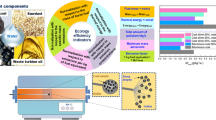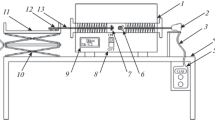Abstract
Statistical analysis findings are presented for typical industrial waste accumulated in the Extreme North and the Arctic, as well as abandoned industrial regions. The analysis has been performed of industrial waste formation in regions exporting energy resources (coal, oil, and gas). A group of waste has been identified that is accumulated in the largest volumes. Advanced methods of its recycling are considered. Advantages and limitations of these methods are outlined. An approach is suggested that is based on preparing slurry fuels from industrial waste by adding water. Laboratory experiments with such slurry fuels have been conducted. Typical values of the following energy performance characteristics are determined: ignition delay times, minimum threshold temperature of combustion initiation, maximum combustion temperature, and heat of combustion. Anthropogenic emission concentrations have been measured (the most hazardous of them are sulfur and nitrogen oxides) from the combustion of slurry fuels under study. Economic, environmental, and energy performance indicators of slurry fuels have been compared with those of conventional energy resources.
Graphic Abstract










Similar content being viewed by others
References
Karcher, M., Hosseini, A., Schnur, R., Kauker, F., Brown, J.E., Dowdall, M., Strand, P.: Modelling dispersal of radioactive contaminants in Arctic waters as a result of potential recovery operations on the dumped submarine K-27. Mar. Pollut. Bull. 116, 385–394 (2017). https://doi.org/10.1016/j.marpolbul.2017.01.034
Quinn, C.L., Armitage, J.M., Breivik, K., Wania, F.: A methodology for evaluating the influence of diets and intergenerational dietary transitions on historic and future human exposure to persistent organic pollutants in the Arctic. Environ. Int. 49, 83–91 (2012). https://doi.org/10.1016/j.envint.2012.08.014
Macdonal, R.W., Barrie, L.A., Bidleman, T.F., Diamond, M.L., Gregor, D.J., Semkin, R.G., Strachan, W.M., Li, Y.F., Wania, F., Alaee, M., Alexeeva, L.B., Backus, S.M., Bailey, R., Bewers, J.M., Gobeil, C., Halsall, C.J., Harner, T., Hoff, J.T., Jantunen, L.M., Lockhart, W.L., Mackay, D., Muir, D.C., Pudykiewicz, J., Reimer, K.J., Smith, J.N., Stern, G.A.: Contaminants in the Canadian Arctic: 5 years of progress in understanding sources, occurrence and pathways. Sci. Total Environ. 254, 93–234 (2000). https://doi.org/10.1016/s0048-9697(00)00434-4
McWatters, R.S., Rutter, A., Rowe, R.K.: Geomembrane applications for controlling diffusive migration of petroleum hydrocarbons in cold region environments. J. Environ. Manage. 181, 80–94 (2016). https://doi.org/10.1016/j.jenvman.2016.05.065
Arctic Climate Impact Assessment (ACIA). Presented at the (2005)
Zheng, J., Chen, B., Thanyamanta, W., Hawboldt, K., Zhang, B., Liu, B.: Offshore produced water management: A review of current practice and challenges in harsh/Arctic environments. Mar. Pollut. Bull. (2016). https://doi.org/10.1016/j.marpolbul.2016.01.004
Arctic Monitoring and Assessment Programme (AMAP): Arctic pollution. Presented at the (2011)
Arctic Monitoring and Assessment Programme (AMAP): Summary for Policy-makers: Arctic Pollution Issues. Presented at the (2015)
Lessard, F., Bussière, B., Côté, J., Benzaazoua, M., Boulanger-Martel, V., Marcoux, L.: Integrated environmental management of pyrrhotite tailings at Raglan Mine: part 2 desulphurized tailings as cover material. J. Clean. Prod. 186, 883–893 (2018). https://doi.org/10.1016/j.jclepro.2018.03.132
Kontorovich, A.E., Epov, M.I., Eder, L.V.: Long-term and medium-term scenarios and factors in world energy perspectives for the 21st century. Russ. Geol. Geophys. 55, 534–543 (2014). https://doi.org/10.1016/j.rgg.2014.05.002
Li, D., Wu, D., Xu, F., Lai, J., Shao, L.: Literature overview of Chinese research in the field of better coal utilization. J Clean Prod (2018). https://doi.org/10.1016/j.jclepro.2018.02.216
Farquharson, D.V., Jaramillo, P., Schivley, G., Klima, K., Carlson, D., Samaras, C.: Beyond global warming potential: a comparative application of climate impact metrics for the life cycle assessment of coal and natural gas based electricity. J. Ind. Ecol. 21, 857–873 (2017). https://doi.org/10.1111/jiec.12475
Whitaker, M., Heath, G.A., O’Donoughue, P., Vorum, M.: Life cycle greenhouse gas emissions of coal-fired electricity generation. J. Ind. Ecol. 16, S53–S72 (2012). https://doi.org/10.1111/j.1530-9290.2012.00465.x
Yang, Z., Zhang, Y., Liu, L., Wang, X., Zhang, Z.: Environmental investigation on co-combustion of sewage sludge and coal gangue: SO2, NOx and trace elements emissions. Waste Manag. 50, 213–221 (2016). https://doi.org/10.1016/j.wasman.2015.11.011
Jianzhong, L., Ruikun, W., Jianfei, X., Junhu, Z., Kefa, C.: Pilot-scale investigation on slurrying, combustion, and slagging characteristics of coal slurry fuel prepared using industrial wasteliquid. Appl. Energy. 115, 309–319 (2014). https://doi.org/10.1016/j.apenergy.2013.11.026
Zhou, H., Yang, Q., Zhu, S., Song, Y., Zhang, D.: Life cycle comparison of greenhouse gas emissions and water consumption for coal and oil shale to liquid fuels. Resour. Conserv. Recycl. (2019). https://doi.org/10.1016/j.resconrec.2019.01.031
Guo, F., Zhong, Z., Xue, H., Zhong, D.: Migration and distribution of heavy metals during co-combustion of sedum plumbizincicola and coal. Waste Biomass Valoriz. 9, 2203–2210 (2018). https://doi.org/10.1007/s12649-017-9955-4
Rohani, V., Takali, S., Gérard, G., Fabry, F., Cauneau, F., Fulcheri, L.: A new plasma electro-burner concept for biomass and waste combustion. Waste Biomass Valoriz. 8, 2791–2805 (2017). https://doi.org/10.1007/s12649-017-9829-9
Liu, C., Huang, Y., Dong, L., Duan, L., Xu, L., Wang, Y.: Combustion characteristics and pollutants in the flue gas during shoe manufacturing waste combustion in a 2.5 MWth pilot-scale circulating fluidized bed. Waste Biomass Valoriz. (2018). https://doi.org/10.1007/s12649-018-0476-6
Vamvuka, D., Sfakiotakis, S.: Thermal behaviour and reactivity of swine sludge and olive by-products during co-pyrolysis and co-combustion. Waste Biomass Valoriz. 10, 1433–1442 (2019). https://doi.org/10.1007/s12649-017-0118-4
Carpenter, A.C., Gardner, K.H.: Use of industrial by-products in urban roadway infrastructure: argument for increased industrial ecology. J. Ind. Ecol. 13, 965–977 (2009). https://doi.org/10.1111/j.1530-9290.2009.00175.x
Glushkov, D., Paushkina, K., Shabardin, D., Strizhak, P., Gutareva, N.: Municipal solid waste recycling by burning it as part of composite fuel with energy generation. J. Environ. Manage. 231, 896–904 (2019). https://doi.org/10.1016/j.jenvman.2018.10.067
Vershinina, K.Y., Shlegel, N.E., Strizhak, P.A.: A comparison of ignition characteristics of slurry fuels prepared using coal processing waste and finely divided coal. J. Energy Inst. 92, 1167–1177 (2019). https://doi.org/10.1016/j.joei.2018.06.001
Adiansyah, J.S., Haque, N., Rosano, M., Biswas, W.: Application of a life cycle assessment to compare environmental performance in coal mine tailings management. J. Environ. Manage. 199, 181–191 (2017). https://doi.org/10.1016/j.jenvman.2017.05.050
Rigamonti, L., Grosso, M., Biganzoli, L.: Environmental assessment of refuse-derived fuel co-combustion in a coal-fired power plant. J. Ind. Ecol. 16, 748–760 (2012). https://doi.org/10.1111/j.1530-9290.2011.00428.x
Dmitrienko, M.A., Strizhak, P.A.: Environmentally and economically efficient utilization of coal processing waste. Sci. Total Environ. 598, 21–27 (2017). https://doi.org/10.1016/j.scitotenv.2017.04.134
Bala-Litwiniak, A., Radomiak, H.: Possibility of the utilization of waste glycerol as an addition to wood pellets. Waste and Biomass Valorization. 10, 2193–2199 (2019). https://doi.org/10.1007/s12649-018-0260-7
Nyashina, G.S., Kurgankina, M.A., Strizhak, P.A.: Environmental, economic and energetic benefits of using coal and oil processing waste instead of coal to produce the same amount of energy. Energy Convers. Manag. 174, 175–187 (2018). https://doi.org/10.1016/j.enconman.2018.08.048
Andreassen, N.: Arctic energy development in Russia—how “sustainability” can fit? Energy Res. Soc. Sci. 16, 78–88 (2016). https://doi.org/10.1016/j.erss.2016.03.015
Meylan, F.D., Moreau, V., Erkman, S.: CO2 utilization in the perspective of industrial ecology: an overview. J. CO2 Util. 12, 101–108 (2015). https://doi.org/10.1016/j.jcou.2015.05.003
Wang, R., Ma, Q., Ye, X., Li, C., Zhao, Z.: Preparing coal slurry from coking wastewater to achieve resource utilization: slurrying mechanism of coking wastewater–coal slurry. Sci. Total Environ. 650, 1678–1687 (2019). https://doi.org/10.1016/j.scitotenv.2018.09.329
Staroń, A., Kowalski, Z., Staroń, P., Banach, M.: Studies on CWL with glycerol for combustion process. Environ. Sci. Pollut. Res. 26, 2835–2844 (2019). https://doi.org/10.1007/s11356-018-3814-0
Shin, Y.-J., Shen, Y.-H.: Preparation of coal slurry with organic solvents. Chemosphere 68, 389–393 (2007). https://doi.org/10.1016/j.chemosphere.2006.12.049
Staroń, A., Banach, M., Kowalski, Z., Staroń, P.: Impact of waste soot on properties of coal-water suspensions. J. Clean. Prod. 135, 457–467 (2016). https://doi.org/10.1016/j.jclepro.2016.06.127
Strizhak, P.A., Vershinina, K.Y.: Maximum combustion temperature for coal-water slurry containing petrochemicals. Energy. 120, 34–46 (2017). https://doi.org/10.1016/j.energy.2016.12.105
Wang, H., Liu, S., Wang, X., Shi, Y., Qin, X., Song, C.: Ignition and combustion behaviors of coal slime in air. Energy Fuels 31, 11439–11447 (2017). https://doi.org/10.1021/acs.energyfuels.7b01960
Morris, J.: Recycle, bury, or burn wood waste biomass?: LCA answer depends on carbon accounting, emissions controls, displaced fuels, and impact costs. J. Ind. Ecol. 21, 844–856 (2017). https://doi.org/10.1111/jiec.12469
Tisserant, A., Pauliuk, S., Merciai, S., Schmidt, J., Fry, J., Wood, R., Tukker, A.: Solid waste and the circular economy: a global analysis of waste treatment and waste footprints. J. Ind. Ecol. 21, 628–640 (2017). https://doi.org/10.1111/jiec.12562
Acevedo, B., Barriocanal, C.: Texture and surface chemistry of activated carbons obtained from tyre wastes. Fuel Process. Technol. 134, 275–283 (2015). https://doi.org/10.1016/j.fuproc.2015.02.009
Strategiya razvitiya Arkticheskoy zony Rossiyskoy Federatsii i obespecheniya natsional’noy bezopasnosti na period do 2020 goda. [Strategy for the development of the Arctic zone of the Russian Federation and national security for the period until 2020]. Utverzhdena Prezidentom Rossiyskoy Federatsii V.V. Putinym 20 fevralya 2013 g. № Pr-232. (In Russian). https://government.ru/info/18360/
Han, S., Chen, H., Long, R., Cui, X.: Peak coal in China: a literature review. Resour. Conserv. Recycl. 129, 293–306 (2018). https://doi.org/10.1016/j.resconrec.2016.08.012
Dmitrienko, M.A., Nyashina, G.S., Strizhak, P.A.: Environmental indicators of the combustion of prospective coal water slurry containing petrochemicals. J. Hazard. Mater. 338, 148–159 (2017). https://doi.org/10.1016/j.jhazmat.2017.05.031
Kumar, A., Sah, B., Singh, A.R., Deng, Y., He, X., Kumar, P., Bansal, R.C.: A review of multi criteria decision making (MCDM) towards sustainable renewable energy development. Renew. Sustain. Energy Rev. 69, 596–609 (2017). https://doi.org/10.1016/j.rser.2016.11.191
Daood, S.S., Ord, G., Wilkinson, T., Nimmo, W.: Fuel additive technology—NOx reduction, combustion efficiency and fly ash improvement for coal fired power stations. Fuel 134, 293–306 (2014). https://doi.org/10.1016/j.fuel.2014.04.032
Wang, Z., Gong, Z., Wang, Z., Fang, P., Han, D.: A TG-MS study on the coupled pyrolysis and combustion of oil sludge. Thermochim. Acta. 663, 137–144 (2018). https://doi.org/10.1016/j.tca.2018.03.019
Miller, J.A., Bowman, C.T.: Mechanism and modeling of nitrogen chemistry in combustion. Prog. Energy Combust. Sei. 4, 287–338 (1989)
Yang, Y., Liu, J., Liu, F., Wang, Z., Zhang, Z.: Comprehensive evolution mechanism of SOx formation during pyrite oxidation. Proc. Combust. Inst. 37, 2809–2819 (2019). https://doi.org/10.1016/j.proci.2018.06.064
Zhou, H., Li, Y., Li, N., Qiu, R., Cen, K.: Conversions of fuel-N to NO and N2O during devolatilization and char combustion stages of a single coal particle under oxy-fuel fluidized bed conditions. J. Energy Inst. 92, 351–363 (2019). https://doi.org/10.1016/j.joei.2018.01.001
Feng, T., Huo, M., Zhao, X., Wang, T., Xia, X., Ma, C.: Reduction of SO2 to elemental sulfur with H2 and mixed H2/CO gas in an activated carbon bed. Chem. Eng. Res. Des. 121, 191–199 (2017). https://doi.org/10.1016/j.cherd.2017.03.014
Liu, G.Q., Liu, Q.C., Wang, X.Q., Meng, F., Ren, S., Ji, Z.P.: Combustion characteristics and kinetics of anthracite blending with pine sawdust. J. Iron Steel Res. Int. 22, 812–817 (2015). https://doi.org/10.1016/S1006-706X(15)30075-3
Castro, R.P.V., Medeiros, J.L., Araújo, O.Q.F., Andrade Cruz, M., Ribeiro, G.T., Oliveira, V.R.: Fluidized bed treatment of residues of semi-dry flue gas desulfurization units of coal-fired power plants for conversion of sulfites to sulfates. Energy Convers. Manag. 143, 173–187 (2017). https://doi.org/10.1016/j.enconman.2017.03.078
Bhui, B., Vairakannu, P.: Prospects and issues of integration of co-combustion of solid fuels (coal and biomass) in chemical looping technology. J. Environ. Manage. 231, 1241–1256 (2019). https://doi.org/10.1016/j.jenvman.2018.10.092
Vershinina, K.Y., Strizhak, P.A.: Ignition of coal suspensions based on water of different quality. Coke Chem. 59, 437–440 (2016). https://doi.org/10.3103/S1068364X16110077
Armesto, L., Bahillo, A., Cabanillas, A., Veijonen, K., Otero, J., Plumed, A., Salvador, L.: Co-combustion of coal and olive oil industry residues in fluidised bed. Fuel 82, 993–1000 (2003). https://doi.org/10.1016/S0016-2361(02)00397-6
Yanik, J., Duman, G., Karlström, O., Brink, A.: NO and SO2 emissions from combustion of raw and torrefied biomasses and their blends with lignite. J. Environ. Manage. 227, 155–161 (2018). https://doi.org/10.1016/j.jenvman.2018.08.068
Zhang, Z., Zeng, Q., Hao, R., He, H., Yang, F., Mao, X., Mao, Y., Zhao, P.: Combustion behavior, emission characteristics of SO2, SO3 and NO, and in situ control of SO2 and NO during the co-combustion of anthracite and dried sawdust sludge. Sci. Total Environ. 646, 716–726 (2019). https://doi.org/10.1016/j.scitotenv.2018.07.286
Shahzad, K., Saleem, M., Kazmi, M., Ali, Z., Hussain, S., Akhtar, N.A.: Effect of hydrodynamic conditions on emissions of NOx, SO2, and CO from co-combustion of wheat straw and coal under fast fluidized bed condition. Combust. Sci. Technol. 188, 1303–1318 (2016). https://doi.org/10.1080/00102202.2016.1190344
Acknowledgments
Research was supported by National Research Tomsk Polytechnic University (Project VIU-ISHFVP-60/2019).
Author information
Authors and Affiliations
Corresponding author
Additional information
Publisher's Note
Springer Nature remains neutral with regard to jurisdictional claims in published maps and institutional affiliations.
Rights and permissions
About this article
Cite this article
Kurgankina, M.A., Nyashina, G.S. & Strizhak, P.A. Ecological Assessment of Industrial Waste as a High-Potential Component of Slurry Fuels. Waste Biomass Valor 12, 1659–1676 (2021). https://doi.org/10.1007/s12649-020-01114-1
Received:
Accepted:
Published:
Issue Date:
DOI: https://doi.org/10.1007/s12649-020-01114-1




